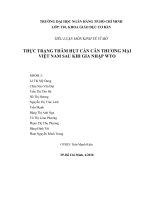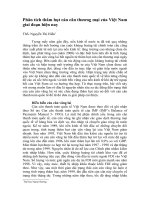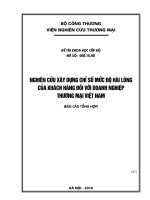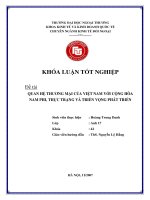Thâm hụt thương mại của Việt Nam với Trung Quốc từ năm 2007-2010 doc
Bạn đang xem bản rút gọn của tài liệu. Xem và tải ngay bản đầy đủ của tài liệu tại đây (1.14 MB, 24 trang )
TRADE DEFICIT
WITH CHINA
OF VIETNAM IN
THE LATE
2000S
LECTURER: DR. TU THUY ANH
FOR E IGN TR A DE UN IVE R
SI T Y
-
HA NOI
–
SU M MER 20 11
TRADE DEFICIT WITH CHINA OF VIETNAM IN THE LATE 2000S
2011
1
Abstract
Trade deficit in general and trade deficit with China is one of the highly concerned
problems of Vietnam macro-economy because long-term trade deficit leads to the
situation of being dependent on foreign economies, the imbalance of BOP, hence, the
whole economy. Examining the severity of the situation and finding the solutions to the
problem is necessary for our sustained economic development. In our research, firstly, we
will analyze the real situation of trade deficit with China with related facts and figures.
Secondly, we explained the reasons for the huge trade deficit with China. Finally, we will
suggest some short-term and long-term solutions to the trade deficit problem. We do this
research in order to give readers the insights, to some extent, into the trade deficit with
China of Vietnam.
TRADE DEFICIT WITH CHINA OF VIETNAM IN THE LATE 2000S
2011
2
TABLE OF CONTENTS
1 The situation of Vietnam’s trade deficit with China 4
1.1 Trade deficit in Vietnam in general 4
1.2 trade deficit with China 7
2 Reasons for the situation of trade deficit with China in Vietnam 11
2.1 Exporting low-added value goods, importing high –value goods 11
2.2 The inefficiency and ineffectiveness of domestic productions and
investments 13
2.3 Chinese various in kinds and low in price goods 14
2.4 The appreciation of Chinese currency 15
2.5 WTO and commitments 17
3 Solutions for the problem of trade deficit with China of Vietnam 18
3.1 Exchange Rate Tool 18
3.2 Capital in-flow and out-flow control 19
3.3 Exporting Spurs 20
3.4 Some other solutions 21
4 Conclusion 22
TRADE DEFICIT WITH CHINA OF VIETNAM IN THE LATE 2000S
2011
3
TR ADE D E F I CI T WIT H C HIN A OF
VI ET NAM I N T HE LA T E 20 0 0S
Student
ID
Ph
ạ
m Thanh H
ả
i
0851050064
Nguy
ễ
n Th
ị
Qu
ỳ
nh Mai
0851050049
Phan Th
ị
Di
ệ
u Linh
0851050046
TRADE DEFICIT WITH CHINA OF VIETNAM IN THE LATE 2000S
2011
4
1 THE SITUATION OF VIETNAM’S TRADE DEFICIT WITH CHINA
1.1 TRADE DEFICIT IN VIETNAM IN GENERAL
Since opening the economy, Vietnam’s trade has increased rapidly. From 1995 to 2008,
in average, the amount of export increased by 18.7%/year while import increased by
20.1% /year. Total amount of import from only 39.3% of GDP in 1995 increased to
99.31% of GDP in 2008. Along with that, the trade deficit increased from 0.27 billion
USD in 1990 to 18.03 billion USD in 2008.
The increase in the export-import turnover make Vietnam’s economy more and more
widen. However, there are many potential risks. The sum of trade deficit in Vietnam from
1990 to 2009 was 84 billion USD, which was larger than GDP in 2008. The ratio trade
deficit over GDP is much larger than other countries in the world.
Year Export (mill USD) Import (mill USD) GDP (mill USD)
1995
5448.9 8155.4 20736.2
1996
7255.9 11143.6 24657.5
1997
9185.0 11592.3 26843.7
1998
9360.3 11499.6 27209.6
1999
11541.4 11742.1 28683.7
TRADE DEFICIT WITH CHINA OF VIETNAM IN THE LATE 2000S
2011
5
2000
14482.7 15636.5 31172.5
2001
15029.2 16218.0 32685.2
2002
16706.1 19745.6 35058.2
2003
20149.3 25255.8 38867.1
2004
26485.0 31968.8 45404.4
2005
32447.1 36761.1 52426.9
2006
39826.2 44891.1 59716.0
2007
48561.4 62764.7 68435.2
2008
62685.1 80713.8 81269.6
Sources: World Bank data, GSO Vietnam
0
2000
4000
6000
8000
10000
12000
14000
16000
18000
20000
19951996199719981999200020012002200320042005200620072008
Trade deficit in Vietnam (million USD)
Trade deficit
TRADE DEFICIT WITH CHINA OF VIETNAM IN THE LATE 2000S
2011
6
Source : World Bank
Import structure: Most of the imported goods of Vietnam are machinery and raw
materials; consumer goods make up less than 10%. Since 2000, imported consumer
goods make up 6-8%, while the number of raw materials is 60-67%. At the moment,
because of being a developing country, the need of raw material as well as machinery is
increasing year by year along with the raise of GDP.
Total 2005 2006 2007 2008
Mill.USD
% Mill.USD
% Mill.USD
% Mill.USD
%
Machinery,
instrument,
accessory
9285.3 25.3 11040.8 24.6 17966.2 28.6 22566.7 29.3
Fuels, raw
material
23663.9 64.4 28463.3 63.4 38822.4 61.9 49149.2 60.9
-15000 -10000 -5000 0 5000 10000 15000 20000
France
UK
Malaysia
Korea
Thai
Germany
Taiwan
Singapore
Australia
China
USA
Japan
Vietnam
France UK
Malaysi
a
Korea Thai
Germa
ny
Taiwan
Singap
ore
Australi
a
China USA Japan
Vietna
m
Trade deficit
-56 934 -823 -4912 -3248 298 -5132 -2172 1227 -11532 8346 -1176 18028
Trade deficit in other countries in 2008 (million USD)
TRADE DEFICIT WITH CHINA OF VIETNAM IN THE LATE 2000S
2011
7
Consumer
goods
2992.5 8.2 3508.4 7.8 4660.1 7.4 6269.9 7.8
Source: gso.gov.vn
1.2
TRADE DEFICIT WITH CHINA
In recent years, the amount of imported goods has increased sharply from 329 million
USD in 1995 to 15973 million USD in 2008. It made up more than 90% of the total
amount of trade deficit of Vietnam. However, it is only official figure. If the amount of
goods smuggled cross borders and goods imported by way of quota are counted, the
number will be higher. The problem here is that the rate of the increase in imported goods
from China is faster and faster while the amount of exported goods stays the same.
1995 1996 1997 1998 1999 2000 2001 2002 2003 2004 2005 2006 2007 2008
Export
361.9 340.2 474.1 440.1 746.4 1536.4 1417.4 1518.3 1883.1 2899.1 3228.1 3242.8 3646.1 4850.1
Import
329.7 329 404.4 515 673.1 1401.1 1606.2 2158.8 3138.6 4595.1 5899.7 7391.3 12710 15974
0
2000
4000
6000
8000
10000
12000
14000
16000
18000
Amount of goods (mill USD)
China Import and Export from 1995 to 2008
TRADE DEFICIT WITH CHINA OF VIETNAM IN THE LATE 2000S
2011
8
In 2007, the trade deficit with China of Vietnam is 9.145 billion USD, making up 64% of
the total amount of trade deficit. In 2008, the figure is 11.16 billion USD and 61%
respectively. In 2010, trade deficit with China was raise to red alert: 12.6 billion USD,
which was equal 105% of the total amount of trade deficit in 2009. Therefore, Vietnam
has failed to decrease the unbalance in trade balance between Vietnam and China.
In 1991, Vietnam mainly traded with Soviet and the socialist countries of Eastern Europe,
through SEV. After the socialist countries collapsed, Vietnam has diverted trade to other
countries such as EU, USA, Australia, Canada, ASEAN, Japan, Korea, etc. A series of
commitments such as FTA, WTO, and AFTA were signed. After the diversion, trade
deficit has been increasing significantly. In 2000, trade surplus from China of Vietnam is
135 million USD. But in 2001, the trade balance switched to deficit of 200 million USD.
From then on, the imports from China have increased sharply. Chinese goods flood
Vietnamese market. Although Vietnam has trade relations with more than 200 countries
and territories, China supplies ¼ raw materials for Vietnam economy.
China USA Japan Germany ASEAN APEC EU
2006
7391.3 987 4702.1 914.5 12546.6 37467.7 3129.2
2007
12710 1700.5 6188.9 1308.5 15908.2 52637.9 5142.4
2008
15973.6 2646.6 8240.3 1479.9 19567.7 67232.2 5581.5
0
10000
20000
30000
40000
50000
60000
70000
80000
Amount of goods (mill USD)
Imports of goods by country and group
TRADE DEFICIT WITH CHINA OF VIETNAM IN THE LATE 2000S
2011
9
In the late of 2009, according to the statistics of Ministry of Industry and Trade, Vietnam
exported mineral materials such as coal, rubber and crude oil to China; making up 55% of
the overall exports. However, the export of this commodity group has to be reduced to
ensure the energy security. In 2009, crude oil was decreased 24% and in 2010 coal was
decreased 50% compared to 2009.
Types 2009 2010
Amount (Tons) Price (1000
USD)
Amount (Tons) Price (1000
USD)
Crude oil
1,032,921 462,623.331 593,997 367,631.9
Coal
20,453,501 935,843.407 14,644,571 961,855.12
Rubber
510,245 856,712.92 464,372 1,420,788.726
Mineral
1,670,233 103,632.823 1,399,846 101,915.301
Aquatic
products
124,857.336 162,557.6
Coffee
17,396 24,885.623 26,499 39,361.779
Total
4,909,025.328
7,308,800.253
Main products exported to China
TRADE DEFICIT WITH CHINA OF VIETNAM IN THE LATE 2000S
2011
10
Types 2009 2010
Amount
(Tons)
Price (1000
USD)
Amount
(Tons)
Price (1000
USD)
Petroleum
2,431,836 1,290,162.315
1,523,028 1,060,887.897
Gas
348,938 201,283.937 318,375 246,794.803
Fertilizer
1,951,305 596,025.776 1,712,004 603,399.522
Textile
1,565,975.737
2,218,368.109
Iron and steel
1,309,888 815,662.347 2,188,545 1,519,043.538
Computers, electronic
products and spare
parts
1,463,551.047
1,682,616.402
Machinery,
equipment,
tools, spare parts
4,155,283.341
4,477,616.444
Total
16,440,951.8 20,018,827.001
Main products imported from China
TRADE DEFICIT WITH CHINA OF VIETNAM IN THE LATE 2000S
2011
11
Compensating for this decline, Vietnam has only agricultural, aquatic and industrial
product. Nevertheless, agricultural and aquatic product made up only 15% of exports to
China. Most Vietnamese exported product to China is raw materials and primary
processing such as fruits, rubber, coffee, pepper, which do not bring great value.
Meanwhile, Chinese imported products are essential goods such as machinery,
components, spare parts and home consuming goods. Therefore, Chinese imported
products have increased overtime. The list of Chinese goods that Vietnam has been
dependent is becoming more sensitive and has close ties to the deep veins of the
economy. For example, Vietnam has intention to increase the purchasing of electricity
from China, with the ratio of 4% of total demand.
Overall, Chinese imported goods has been increasing year by year. Vietnam is now more
dependent on China than ever.
2 REASONS FOR THE SITUATION OF TRADE DEFICIT WITH
CHINA IN VIETNAM
2.1 EXPORTING LOW-ADDED VALUE GOODS, IMPORTING HIGH –VALUE GOODS
The main exported goods of Vietnam such as shoes, pepper, coffee bean, cashew, rice
have low value added in the value chain; therefore, their contributions to the export value
are comparatively low. Moreover, the export of these goods has to depend on the
equivalent input materials imported from China.
TRADE DEFICIT WITH CHINA OF VIETNAM IN THE LATE 2000S
2011
12
Source: www.gso.gov.vn
From the figures of main import and export goods in 2010 of the GSO of Vietnam, it can
be inferred that most of the main exported goods into China have relatively low value in
comparison with the necessary equivalents inputs imported from China. For example, we
export crude oil for more than 350 million USD but at the same time import refined oil
for more than 1 billion USD. Similarly, we export shoes for more than 3 million but
import shoes and shoes’ materials for 671 million. Worse still, in garment and textile, we
export for about 93 million USD but import for 2,218 million USD.
TRADE DEFICIT WITH CHINA OF VIETNAM IN THE LATE 2000S
2011
13
2.2 THE INEFFICIENCY AND INEFFECTIVENESS OF DOMESTIC PRODUCTIONS
AND INVESTMENTS
Firstly, basing on the Incremental Capital Output Ratio (ICOR), Vietnam has a rather
high ratio.
ICOR =
The higher the ratio is, the less efficient the investment becomes.
Source: CEIC Data Company Ltd: and IMF staff calculations
It can be inferred from the chart above that Vietnam had a relatively high annual average
Incremental Capital-Output ratios in the period 2000-2008 in comparison with some
Asian countries. It means that our investment was not comparably effective. This is one
of the core reasons leading to the inadequate domestic supply of goods and services. The
0
1
2
3
4
5
6
ANNUAL AVERAGE ICOR 2000-2008
ANNUAL AVERAGE ICOR 2000-
2008
TRADE DEFICIT WITH CHINA OF VIETNAM IN THE LATE 2000S
2011
14
situation becomes worse when the domestic demand for goods is increasing sharply
ranging from necessary goods such as daily foods, vegetable, clothes to durable and
luxurious goods such as cars, cosmetics. However, the domestic production is not enough
to supply all needed goods and services. The domestic insufficient supply ranges from
iron and steels, input material for garment and textiles, fertilizers to motor and
automobile spare parts.
On the other hand, domestic producers cannot self-supply some kinds of high-tech inputs,
primary materials for our goods and services because of the complex skills, knowledge
and know-hows required. For example, in the case of production of automobile and
motors, the main value added is from the assembly of spare parts imported from China,
which add up relatively low value. In this sector, import takes up two-thirds of exported
value.
Worse still, some kinds of products those can be domestically supplied do not meet
requirement or tastes of consumers. At that time, the domestic products which meet the
quantitative demand only cannot be consumed. All in all, our domestic production cannot
meet domestic demand in both quantitative and qualitative aspects of the goods and
services.
2.3 CHINESE VARIOUS IN KINDS AND LOW IN PRICE GOODS
Chinese is said to be the workshop of the world which offer the equivalent goods at very
low price in comparison with most countries in the world, Vietnam included. The low-
price is one of the most important competitiveness of Chinese goods. For example,
Chinese steels are 10% cheaper than domestic steels; Made-in-Vietnam clothes are up to
50% more expensive than those in China. In the case of fresh fruits, vegetables, one of
the main imported goods from China, imported value has amounted to 156.13 million
USD, taking up 53.1% of imported value from foreign countries of Vietnam. Even the
exclusively special fruits of Vietnam such as citrus fruits, water-melon, etc. are now
imported from China. Some other goods such as garlic, ginger, carrots are half the price
TRADE DEFICIT WITH CHINA OF VIETNAM IN THE LATE 2000S
2011
15
of those from Vietnam’s origin. In addition, these fruits, additives, vegetables can be
preserved longer than those of Vietnam.
One of the main reasons of the cheap goods in China in comparison with Vietnam is that
in China, the input materials are available, labor is cheap. At that time, we cannot supply
input materials ourselves. We have to import, instead. Therefore, it is difficult for the
equivalent or similar goods made in Vietnam to regain the domestic market, not to
mention entering the Chinese market.
Another obstacle to Vietnam goods is the distribution channels. Chinese producers with
the advantage of low price can offer a high discount for agents in Vietnam, thus, they
easily dominate our market.
Moreover, Chinese goods are various in kinds, fitting most kinds of ages, tastes,
purposes. For example, clothes from China are saturated in Vietnam market with various
kinds, size, attractive designs and reasonable price, targeted at and dominated the market
for low and middle – in come consumers.
2.4 THE APPRECIATION OF CHINESE CURRENCY
On June, 2010, People’s Bank of China (PBC) formally revalued its official exchange
rate against USD about 0.45%, from 6.827 to 6.7980, marking the first revaluation from
July, 2008. 3 weeks after the coming into force of the decision, CNY appreciated by
0.8% at 6.7746 CNY/USD and are expected to be at 6.5 CNY/USD at the end of the year
2011.
According to the Government of China, domestic investment decreased, limited import
and promoted export. Considering the table below, it can be referred that the revaluation
increased trade deficit with China dramatically.
TRADE DEFICIT WITH CHINA OF VIETNAM IN THE LATE 2000S
2011
16
Source: extracted from figures of www.gso.gov.vn
From the table above, trade deficit with China rose three months continuously by 1.5%
from June, 2010 to September, 2010 and the trade deficit of the first 9 months of 2010
increased by 46.17% in comparison with trade deficit of the same periods in 2009.
Source: extracted from figures of www.gso.gov.vn
Chinese official currency (CNY) was adjusted to increase 279 basis points during the
year 2010, or 0.45% against the U.S. dollar. The adjustment often imply the more
balanced BOP but in case of Vietnam, the modest increase in export turnover is eaten up
by the huge increase in import turnover caused by the appreciation of CNY against VND.
The appreciation of CNY, to some extent, discourages the trade flow into Vietnam but
most of the imported goods from China cannot be substituted by domestic productions.
For example, input materials for our main exported goods such as garment and textiles,
shoes, steels, spare parts, machines cannot be cut off because the domestic market is
unable to supply them.
One more impact of the appreciation of the CNY is the increased foreign direct
investment from China into Vietnam. With this scenario, the flow of machines, tools,
TRADE DEFICIT WITH CHINA OF VIETNAM IN THE LATE 2000S
2011
17
input from China rises sharply, which obviously alleviates the huge trade deficit between
two countries.
2.5 WTO AND COMMITMENTS
The participation of Vietnam into World Trade Organization (WTO) marks an important
milestone in our economic development, which serves as a chance for spreading our
wings. However, our economy has to face with rather stiff competitions from WTO’s
members, China included. We have to liberalize trade by removing, step by step, various
tariff- and non-tariff-barriers, which have protected our infant industries from outside
competitions. The liberalization of trade barriers and commitment to reduce
protectionism exposes domestic infant industries to many threats. Many of our infant
industries such as paper industry, steels industry, clothes cannot compete with foreign
ones. Thus, the stiff competitiveness will undermine our industries. At that time, we have
to import more, which will alleviate the problem. This leads to the dramatic decreases in
imported goods and services.
One obvious example of the collapse of domestic industry is Viet Tri’s Sugar Company
and Hong Ha Beer Company in Phu Tho Province. These two companies cannot compete
with the low price Sugar from China in around the year 2000 and had to declare
bankrupt. After these collapses, the sugar price increased sharply by 100% within 1 year,
from about 280 USD/ton to 565 USD/ton.
In fact, according to Mr. Nguyen Ba Dinh, vice-director of Cat Lai Customs Department,
many Chinese agricultural products are treating at the 0%-tariff. Therefore, the import
limitations by tariff are not applicable. Moreover, technical barriers to trade (TBTs) and
Sanitary & Phyto-sanitary measures (SPs) have not been created and applied yet. Thus,
Chinese goods freely move into and out of our countries just as the domestic goods and
services.
TRADE DEFICIT WITH CHINA OF VIETNAM IN THE LATE 2000S
2011
18
3 SOLUTIONS FOR THE PROBLEM OF TRADE DEFICIT WITH
CHINA OF VIETNAM
The imbalance of trade, especially the trade deficit, which refers to the excess of import
over export, is often considered a big issue to a national economy. Generally, persistent
trade deficit is harmful to the economy while it leads to the foreign exchange gap and
foreign exchange scarcity. As a result, the country’s position in international payment
will be reduced. So, improving trade balance or reducing the trade deficit takes a lot of
concern of policy makers.
3.1 EXCHANGE RATE TOOL
There is a bund of factors that take effect on the trade balance, for constant, domestic
GDP, foreign income, commodity prices and exchange rate. Among them, exchange rate
is regarded as an important tool because of its significant impact on the exports and
imports of a country.
Theoretically, depreciation of nominal exchange rate will spurs exporting and deters
importing, thus improving trade balance. As a result, devaluation is often recommended a
good instrument in stabilization programmed for improving trade balance for countries
suffered from trade deficit.
Practically, the result may be not as expected. Some countries succeeded in improving
trade balance by devaluation but some failed.
In the case of Vietnam, The Dong/USD rate has remained broadly stable. The
continuation of this policy in the face of persistent large capital inflows would require a
return to significant foreign exchange intervention.
We would encourage the authorities to allow the Dong to be more responsive to
pressures on the exchange rate.
TRADE DEFICIT WITH CHINA OF VIETNAM IN THE LATE 2000S
2011
19
In the short run, this would ease the need for foreign exchange intervention and
sterilization.
In the longer run, greater exchange rate flexibility would create an incentive to manage
exchange rate risks effectively, deepen further financial markets, and help enhance
Vietnam's resilience to external shocks
3.2 CAPITAL IN-FLOW AND OUT-FLOW CONTROL
In short-term, we can in some way depend on FDI or FII, and loan for solving the
payment balance. By that way, we should continue to promote investment, attract FDI,
especially for the large-scale projects; tighten the control and supervision over project
implementation aiming at ensuring transparency and reducing corruption. However, this
is only short-term solution while the foreign loans are always accommodated with some
special conditions, which can affect other sides of the country such as the politics, social
or environment.
It is also encouraged to push up the overseas transfer to have a stable capital resource.
However, transferring domestic currency abroad encounters some obstacles, while there
are not many of business that have a large of capital budget to take risk.
Moreover, the authorities should rein in credit growth and enhance prudential oversight
of banks, especially of the joint stock banks that have extended credit at a particularly
high pace.
The authorities could direct the central bank to increase interest rates for the loans of
foreign currency, reduce foreign currency sales or offer exporters above-market rates for
foreign currencies to ensure an adequate supply of foreign currencies in the domestic
economy. This helps to increase Foreign Currency Reserve to encourage and guarantee
for foreign investors.
TRADE DEFICIT WITH CHINA OF VIETNAM IN THE LATE 2000S
2011
20
3.3 EXPORTING SPURS
Vietnam Government must establish more incentive policy for exporting production
industry to cool down the deficit and (maybe) become the exporting driving countries
with the positive situation in trade balance.
We can prop exporting to China and divert the importing market from China to others
such as Japan, EU or US. However, this will not make much sense while the Vietnamese
products are still limited in the style, quality and especially with higher price than
Chinese products. Diverting the importing from China market into other markets also
does not help much with the trade deficit although these products from those countries
may be more premium than Chinese products, but the importing prices are also higher.
Thus the total trade deficit may even become worse.
We can reduce and even replace the imported products by domestic products. However,
the key of policy for economic growth lies in the exporting, not to replacing importing.
To increase export turnover and reduce trade deficit, the Ministry of Industry and Trade
called on businesses to seek new outlets for export and strengthen their marketing efforts
in Asian, Euro and North American markets, etc. As a matter of fact, the current
exporting products of Vietnam are mainly raw materials or commodities with low value
added. This means that the more we exports, the more we imports. Lacking of
fundamental investment plans for industry of fuels, machinery and equipment resulted in
the excess importing, etc. Overall, a fundamental solution to the excess importing in
general and excess importing from China in detail is to reduce the relative demand of
importing products to exporting ones of Vietnamese people. The authorities should have
policies to encourage the capacity of the domestic industry as well as the competitiveness
and the market share of domestic products.
TRADE DEFICIT WITH CHINA OF VIETNAM IN THE LATE 2000S
2011
21
3.4 SOME OTHER SOLUTIONS
a. Importing and exporting structure diversification
The structure of our importing and exporting market concentrates on some of the markets
which have suffered deeply from the world financial crisis. Thus, it is needed to provide
incentives for transnational companies as long as with the net of Vietnamese business to
penetrate in other markets such as East Middle, Africa, and NAFTA and develop the
market share in the old market known as Eastern Europe.
b. Domestic market developing
It is important to exploit all the potential capacity of the domestic market to slow down
the speed of our importing, reducing the addiction of Vietnam in importing raw material
and resources from other countries. Investing in R & D, updating high technology and
increase the value added rate in products. Some of our exporting business in cotton
manufactures or foot wear industry, who has met the demand of big markets such as
America, Europe and Japan, should have exploited more the domestic market to deal with
the financial crisis.
c. Supporting industries developing
The supporting industries take a very important role in improving our situation of over
importing. Supporting industries will be the solution to the problem of our importing raw
materials and resources from other countries. It is helpful to increase our competitiveness
of our market on the international market and makes ease for the supply chain
management. Supporting industries investments could also create a lot of jobs, attracting
abundant labors, reducing the stress of unemployment. To help with development of
supporting industries, the government is said to provide more incentives for domestic
firms to produce supporting goods competitive in prices.
TRADE DEFICIT WITH CHINA OF VIETNAM IN THE LATE 2000S
2011
22
In conclusion, the issue of Vietnam trade deficit which caused by excess importing
Chinese products needs a mixed solution to make it better. Among them are exchange
rate instrument, money flows control or the restructure in Vietnam industry. This problem
even requires the change in the thinking about economic growth at the highest level.
4 CONCLUSION
In conclusion, trade deficit with China in Vietnam is becoming greater and greater in the
2000s. The underlying reasons are both subjective and objective. On the one hand, trade
deficit comes from the advantages of low price and wide variety of China’s goods, from
the revaluation of Chinese Yuan (CNY) and the commitments of trade liberalization of
the WTO. On the other hand, trade deficit is caused by the subjective reasons of our
economy. In fact, our investment and production is inefficient and insufficient, both in
qualitative and quantitative ways. We cannot self-supply the important inputs, materials
and high-tech spare parts for the domestic demand. Therefore, we should, in short-term,
control the inflow and outflow of goods and services by using exchange rate tools.
However, in the long-term, we have to upgrade our economy as a whole in order to
gradually replace current imported commodity. We have to add more competitiveness to
our domestic goods and services instead of only low-price goods, basing on cheap labor
and natural resources. By that way, we could guarantee our sustainable growth, which is
the desirable target of any economy in the world.
TRADE DEFICIT WITH CHINA OF VIETNAM IN THE LATE 2000S
2011
23
References:
General Statistics Office of Vietnam gso.gov.vn
World Bank worldbank.org
International Monetary Fund imf.org








